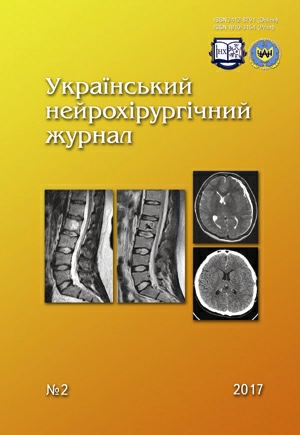Potentialities of evaluation of serum level of S100B for predicting the consequences of severe traumatic brain injury
DOI:
https://doi.org/10.25305/unj.104504Keywords:
traumatic brain injury, prognosis, biomarkers, S100BAbstract
The objective was to evaluate the potentialities of determining serum level of astroglial biomarker S100B for predicting the consequences of a severe traumatic brain injury (TBI).
Methods. We used the results of diagnostic tests and therapeutic manipulations in 72 patients aged 16 to 76 years with severe traumatic brain injury of different origin with the assessment of its outcomes. The results of the molecular biological study (determining S100B serum concentration by solid phase enzyme immunoassay — ELISA using sets of reagents Sigma-Aldrich, USA, on the 1st day after severe TBI) compared with the analyzes of 10 healthy donors. The outcomes of TBI were assessed by Glasgow Outcome Scale (GOS) in 6 months after injury. A correlation of severe TBI outcomes with S100B serum levels obtained on the 1st day after injury was evaluated.
Results. In patients with isolated severe TBI, after exclusion of concomitant extracranial injuries, intoxication and other causes for unconsciousness, serum levels of S100B exceeding the cut-off value of 1.35 ng/ml indicated most likely probability of patient’s death (model sensitivity 97.1 %, specificity 81.6 %). The levels of serum S100B exceeding the cut-off value of 1.30 ng/ml on the 1st day after severe TBI implied a high probability of unfavorable outcomes in 6 months after the trauma, which include death and severe disability (model sensitivity 88.1 %, specificity 86.7 %).
Conclusion. The estimation of serum concentration of astroglial damage biomarker S100B in patients with severe TBI on the 1st day after injury was found to be highly efficient to predict the outcomes of TBI in 6 months after injury.
References
1. Steyerberg EW, Mushkudiani N, Perel P, Butcher I, Lu J, McHugh GS, Murray GD, Marmarou A, Roberts I, Habbema JD, Maas AI. Predicting outcome after traumatic brain injury: development and international validation of prognostic scores based on admission characteristics. PLoS Med. 2008;5(8):e165. [CrossRef] [PubMed]
2. Corrigan JD, Selassie AW, Orman JA. The epidemiology of traumatic brain injury. J Head Trauma Rehabil. 2010;25(2):72-80. [CrossRef] [PubMed]
3. Tagliaferri F, Compagnone C, Korsic M, Servadei F, Kraus J. A systematic review of brain injury epidemiology in Europe. Acta Neurochir (Wien). 2006;148(3):255-68. [PubMed]
4. Thelin EP, Jahannesson L, Nelson D, Bellander B. S100B is an important outcome predictor in traumatic brain injury. J Neurotrauma. 2013;30(7):519-28. [CrossRef] [PubMed]
5. Lee JY, Lee CY, Kim HR, Lee CH, Kim HW, Kim JH. A role of serum-based neuronal and glial markers as potential predictors for distinguishing severity and related outcomes in traumatic brain injury. J Korean Neurosurg Soc. 2015;58(2):93-100. [CrossRef] [PubMed]
6. Goyal A, Failla MD, Niyonkuru C, Amin K, Fabio A, Berger RP, Wagner AK. S100b as a prognostic biomarker in outcome prediction for patients with severe traumatic brain injury. J Neurotrauma. 2013;30(11):946-57. [CrossRef] [PubMed]
7. Biloshytsky V, Kobyletsky O. [Possibilities of biochemical biomarkers in prognosis of traumatic brain injury course]. Ukrainian Neurosurgical Journal. 2015;(1):4-15. Ukrainian. [Abstract/Full Text]
8. Mondello S, Jeromin A, Buki A, Bullock R, Czeiter E, Kovacs N, Barzo P, Schmid K, Tortella F, Wang KK, Hayes RL. Glial neuronal ratio: a novel index for differentiating injury type in patients with severe traumatic brain injury. J Neurotrauma. 2012; 29(6):1096-104. [CrossRef] [PubMed]
9. Kobyletsky OY, Bielska LM, Shevaha VM, Biloshytsky VV. [Evaluation of serum ubiquitin C-terminal hydrolase L1 as a predictor of severe traumatic brain injury outcomes]. Ukrainian Neurosurgical Journal. 2017;(1):24-32. Ukrainian. [Abstract/Full Text]
10. Lo TY, Jones PA, Minns RA. Combining coma score and serum biomarker levels to predict unfavorable outcome following childhood brain trauma. J Neurotrauma. 2010;27(12):2139-45. [CrossRef] [PubMed]
11. Papa L, Robertson CS, Wang KK, Brophy GM, Hannay HJ, Heaton S, Schmalfuss I, Gabrielli A, Hayes RL, Robicsek SA. Biomarkers improve clinical outcome predictors of mortality following non-penetrating severe traumatic brain injury. Neurocrit Care. 2015;22(1):52-64. [CrossRef] [PubMed]
Downloads
Published
How to Cite
Issue
Section
License
Copyright (c) 2017 Oleg Y. Kobyletsky, Lyudmyla M. Bielska, Volodymyr M. Shevaha, Vadym V. Biloshytsky

This work is licensed under a Creative Commons Attribution 4.0 International License.
Ukrainian Neurosurgical Journal abides by the CREATIVE COMMONS copyright rights and permissions for open access journals.
Authors, who are published in this Journal, agree to the following conditions:
1. The authors reserve the right to authorship of the work and pass the first publication right of this work to the Journal under the terms of Creative Commons Attribution License, which allows others to freely distribute the published research with the obligatory reference to the authors of the original work and the first publication of the work in this Journal.
2. The authors have the right to conclude separate supplement agreements that relate to non-exclusive work distribution in the form of which it has been published by the Journal (for example, to upload the work to the online storage of the Journal or publish it as part of a monograph), provided that the reference to the first publication of the work in this Journal is included.









